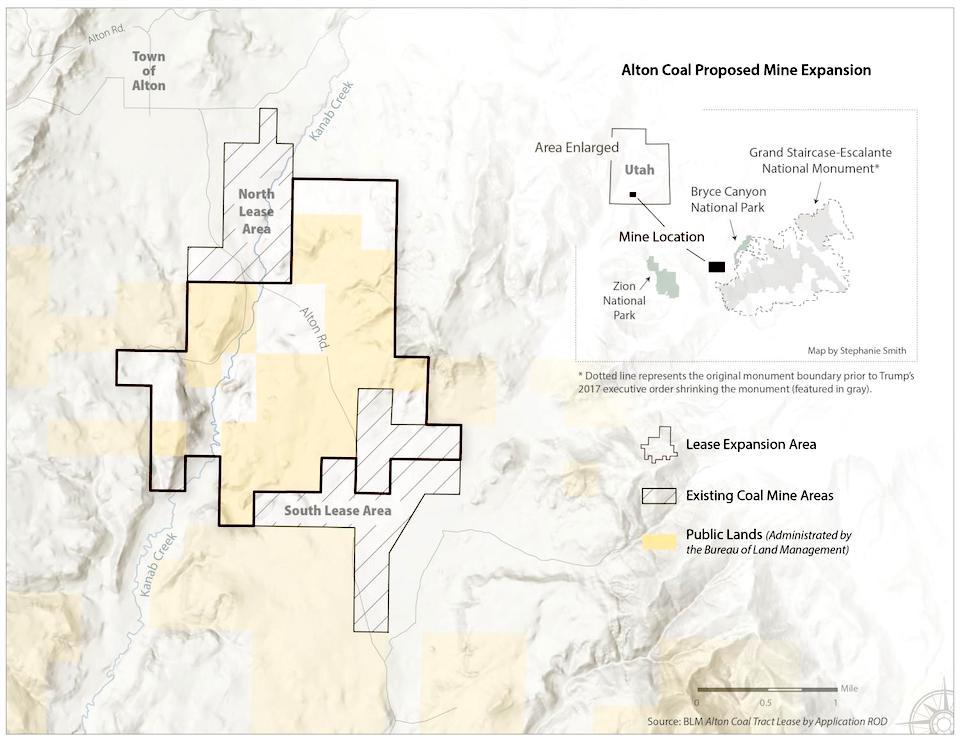
Map of Alton Coal Co. mine expansion in Utah/Stephanie Smith, Grand Canyon Trust
Two months after the Trump administration allowed a coal mine not far from Bryce Canyon National Park in Utah to expand, a lawsuit was filed on grounds the expansion plan wasn't rigorously analyzed for its impact on the environment.
The Interior Department in mid-February approved the Alton Coal Co.'s operations at the Coal Hollow Mine, which opened in 2010, to expand to nearly 3,500 acres roughly ten miles west of Bryce Canyon.
On Tuesday the Sierra Club, Natural Resources Defense Council, National Parks Conservation Association, Grand Canyon Trust, Utah Physicians for a Healthy Environment, and WildEarth Guardians brought a lawsuit alleging that Interior officials didn't follow the National Environmentla Policy Act in approving the expansion. They maintain the expanded mine will exacerbate climate change impacts and create air pollution. More specifically, the complaint argues that Bureau of Land Management staff failed to analyze the impacts of mercury pollution from burning coal, did not consider the enormous social costs of increased carbon emissions, and refused to take a broader, more cumulative look at the climate impacts of this project as required under NEPA.
Additionally, the lawsuit claims, the mine expansion threatens natural resources and animals, including North America’s southernmost population of Greater Sage Grouse. Expanding the coal mine onto publicly owned land threatens to negatively impact the visitor experience at nearby Bryce Canyon and will infringe upon numerous activities that thousands of people enjoy in Utah, it adds.
“The expansion of the strip mine operation near Bryce Canyon National Park is the latest in a series of actions by BLM focused on degrading our public lands in the interest of short-term gains from energy extraction,” according to Cory MacNulty, associate director of the Southwest Region at the National Parks Conservation Association. “Expansive views across the colorful hoodoos, clean clear air, natural quiet and dark, starry night skies are integral to the national park experience at Bryce Canyon–yet all are at risk from expansion of the Alton coal mine.”
“The country surrounding the mine is so spectacular that it’s hard to imagine any reckoning that could justify strip-mining coal there,” said Aaron Paul, a staff attorney for the Grand Canyon Trust. “But the least our government should do before auctioning off our public-lands inheritance to run coal-fired power plants is tell us roughly how much the resulting climate debt will impoverish us all.”
Jonny Vasic, executive director for Utah Physicians for a Healthy Environment, added that "there is no safe level of air pollution exposure. Even levels far below the EPA’s national standards precipitate a long list of human diseases, acceleration of the aging process and premature death. The pollution from the mine itself and the transportation and burning of the coal represents a multi-stage health hazard to people throughout Southern Utah and beyond. The BLM pretended that was not an issue."
Alton Coal has proposed running coal trucks 10 minutes apart 24 hours a day, six days a week from the mine. Their route would take them 30 miles north on U.S. 89 to Panguitch, and then west on State Route 20 to Interstate 15, and then south to a location near Cedar City where the company envisions a railhead to send the coal to the West Coast.
Both 89 and 20 are winding, rolling, two-lane routes that pass through broken forests of pine, juniper and aspen as they connect Zion National Park, Bryce Canyon National Park, and Cedar Breaks National Monument. During summer those roads are full of tourist traffic that includes a good number of ponderous recreational vehicles. In Panguitch, which funnels south-bound traffic to Bryce Canyon, U.S. 89 goes through the middle of town and requires a 90-degree turn for both north-bound and south-bound traffic.
In studying the expansion, BLM staff noted there were issues with it. Business owners in Panguitch have voiced concerns at such an increase in coal truck traffic, the agency's Final Environmental Impact Statement noted. In the past, Dixie National Forest staff expressed concerns how the mine could impact air and water quality in the forest and impact scenic visitas and wildlife habitat.
Latest economic figures show the tourism industry greatly dwarfs the coal industry in Utah, generating $9.1 billion in overall traveler spending vs. $600 million in coal production.



Comments
we are planning a trip to the southwest Page Az Zion Mesa verde and had planned on going to Bryce but since the trip is an important celebration and we don't want to deal with coal trucks and pollution we are going to skip the two days we had thought to spend in Bryce Canyon and go to Sedona instead. It's not worth risking and the knowledge that dirty coal and noisy trucks is too close for comfort. It's a shame. The expansion of coal mining in this beautiful area is a bad BAD idea that will definitely affect visitor deciding on which south western locations to spend their money. It's also sad that people are not using their brains and finding green energy solutions and a better way to make a living.
Tracy, you are doing yourself a disservice. While you might run into heavier traffic on your way to the park, once there you will never know that the mine even exists.
I agree with you Tracy. I was looking at property in Panguitch. I love the small town expetience and the beauty of Garfield county . I Spend 2-4 months a year visiting Utah . It's so disheartening that coal will he polluting the air we breathe and the lakes in the area. I'm changing my plans as well. its Sad at all the beautiful wilderness areas in Utah being threatened in the name of 'jobs'. say It like it is.... it's for the all mighty dollar .